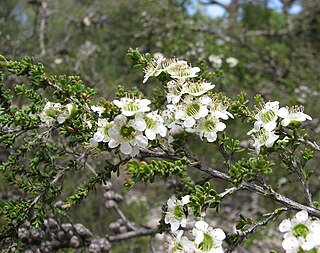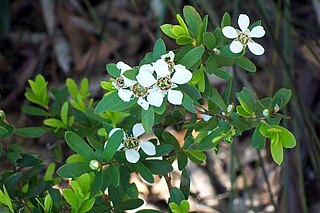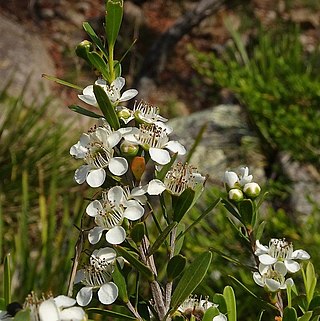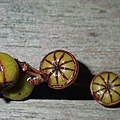
Leptospermum is a genus of shrubs and small trees in the myrtle family Myrtaceae commonly known as tea trees, although this name is sometimes also used for some species of Melaleuca. Most species are endemic to Australia, with the greatest diversity in the south of the continent, but some are native to other parts of the world, including New Zealand and Southeast Asia. Leptospermums all have five conspicuous petals and five groups of stamens which alternate with the petals. There is a single style in the centre of the flower and the fruit is a woody capsule.

Leptospermum petersonii, commonly known as lemon-scented teatree, is a species of shrub or small tree that is endemic to eastern Australia. It has thin, fibrous or flaky bark, often strongly-scented elliptic to lance-shaped leaves, white flowers and fruit that are retained for several years. It is commonly grown as an ornamental and is regarded as a minor environmental weed in some areas.

Leptospermum liversidgei, commonly known as the olive tea-tree, is a species of compact shrub that is endemic to eastern Australia. It has narrow egg-shaped, lemon-scented leaves, white or pink flowers and woody fruit that remain on the plant at maturity.

Leptospermum lanigerum, commonly known as the woolly teatree, is a small tree or medium shrub from the plant family Myrtaceae. Its common name derives from the conspicuously hairy capsules produced as fruit, along with the fine, silky hairs present on branches and leaves. L. lanigerum is widespread in many habitats, particularly in waterlogged areas such as moist, sandy coastal heaths, on river banks, riparian scrub, woodlands and on the fringe of montane grasslands. This species is endemic to Australia, with native populations occurring in New South Wales, South Australia, Tasmania and Victoria.

The Leptospermum grandifolium, commonly known as mountain tea-tree or woolly teatree, is a species of shrub or small tree that is endemic to south-eastern Australia. It has elliptical to egg-shaped leaves with a sharp point on the tip, white flowers and relatively large, broadly hemispherical fruit.

Leptospermum trinervium, commonly known as flaky-barked tea-tree, slender tea-tree or paperbark tree, is a species of shrub or small tree that is endemic to eastern Australia. It has papery bark that is shed in thin, flaking layers, narrow elliptic to broadly egg-shaped leaves with the narrower at the base, white flowers and silky-hairy fruit that falls from the plant when mature.

Leptospermum continentale, commonly known as prickly tea-tree, is a species of slender, straggling shrub that is endemic to south-eastern Australia. It has sharp-pointed, narrowly egg-shaped leaves, white flowers arranged singly in leaf axils and woody fruit that remains on the plant when mature.

Leptospermum myrsinoides, commonly known as the heath tea-tree or silky tea-tree, is a species of shrub that is endemic to south-eastern continental Australia. It has smooth bark on the younger stems, narrow egg-shaped leaves with the narrower end towards the base, white flowers and fruit that has the remains of the sepals attached but usually falls from the plant soon after the seeds are released.

Leptospermum obovatum, commonly known as river teatree, is a species of shrub that is endemic to south-eastern continental Australia. It has egg-shaped or lance-shaped leaves that are narrower at the base, white flowers usually arranged singly on short side shoots and fruit that remains on the plant until it dies.

Leptospermum sericeum, commonly known as the silver tea tree, is a species of shrub that is endemic to the south-west of Western Australia. It has thin, firm bark, egg-shaped leaves with the narrower end towards the base, relatively large, pink flowers and fruit that fall from the plant with the seeds. It grows in windswept rock crevices near Esperance.

Leptospermum rotundifolium, commonly known as round-leaved tea tree, is a species of flowering plants in the family Myrtaceae and is endemic to New South Wales, naturalised in Victoria and Western Australia. It is an erect shrub with more or less circular leaves but with a small point on the tip, and relatively large pink or white flowers.

Leptospermum glaucescens, commonly known as the blue-green tea tree or smoky tea tree, is a species of shrub or small tree that is endemic to Tasmania. It has elliptical to egg-shaped leaves that are often greyish green, white flowers about 15 mm (0.59 in) in diameter arranged in consecutive leaf axils and fruit that remain on the plant for some time after maturity.

Leptospermum coriaceum, commonly known as green tea-tree or mallee teatree, is a shrub species that is endemic to south-eastern and south-central Australia. It has smooth bark on the younger stems, elliptic to narrow egg-shaped leaves, white flowers and woody fruit. The usual habitat is mallee on sand dunes.

Leptospermum brevipes, commonly known as the slender tea-tree, is a species of shrub or small tree that is endemic to eastern Australia. It has fibrous bark on the main stems, smooth bark on young stems, narrow elliptical to narrow egg-shaped leaves, white flowers and hemispherical fruit that is shed when mature.

Leptospermum emarginatum, commonly known as the twin-flower tea-tree or twin flower teatree, is a species of shrub that is endemic to south-eastern Australia. It has rough bark on the older stems, lance-shaped leaves with the narrower end towards the base and a small notch at the tip, white flowers in groups of up to five and hemispherical fruit that falls off when mature.

Leptospermum glabrescens, commonly known as the smooth teatree, is a shrub or small tree that is endemic to East Gippsland in Victoria, Australia. It has linear, elliptic or narrow egg-shaped leaves, white flowers arranged singly on short side shoots and fruit that remain on the plant.

Leptospermum grandiflorum is a species of shrub or small tree that is endemic to eastern Tasmania. It has thick, elliptical to egg-shaped, greyish green leaves, white flowers about 20 mm (0.79 in) in diameter arranged singly on short side branches, and fruit that remain on the plant for long time after reaching maturity.

Leptospermum myrtifolium, commonly known as the myrtle tea-tree or grey tea-tree, is a species of shrub that is endemic to south eastern Australia. It has broad egg-shaped to elliptical leaves, white flowers usually borne singly on short side shoots, and fruit that remains on the plant until it dies.
Leptospermum riparium, commonly known as riverine tea-tree, is a species of straggling shrub that is endemic to Tasmania. It has flaky bark, crowded, lance-shaped leaves with the narrower end towards the base, relatively large white flowers and fruit that remain on the plant when mature. It grows on river banks in rainforest.

Leptospermum wooroonooran, commonly known as wurunuru or mountain teatree, is a species of stunted tree that is endemic to Queensland where it grows on exposed mountain ridges. It has thin, fibrous or flaky bark, lance-shaped leaves with the narrower end towards the base, white flowers arranged singly on short side shoots and fruit remain on the plant at maturity.
























